Harmony and Simplicity Meet at Hachi Ju Hachi in Saratoga
At Hachi Ju Hachi, the Japanese restaurant in downtown Saratoga, you won’t find the standard menu of teriyaki, Philly rolls, and Bento Box “A”’s like that of so many other establishments. Nor will you find bells, whistles, over-the-top flourishes or modern sensibilities that jar and shock.
Instead, you will find dishes with a real purity of flavor and lovely simplicity.
Chef-Owner Jin Suzuki may be only 45 years old, but he is decidedly old-school when it comes to cooking.
At 19, he started his training as a chef at a restaurant just outside of Tokyo. For six months, all he did was clean the windows and floors. He wasn’t even allowed to step foot inside the kitchen to wash dishes. It would be another three years before he was allowed to wash the rice. All of this had a profound effect on him.
“The more I saw, the more I got curious,” he says. “I learned that in-between confidence and arrogance is humility. So many chefs can be good technically. But so few chefs can attain spirituality in their cooking.”
One need only glimpse Suzuki, with his crisp chef’s coat, perfectly knotted tie, geta sandals, and serene composure to know this is a chef who has indeed attained that.
The name of the restaurant, Hachi Ju Hachi, which opened in November, comes from the word for “rice” in Japanese. Taken apart, the kanji characters represent the number,”88.” Whether it was fate or not that led Suzuki to this exact location to open his restaurant is anyone’s guess. All he knows is that a few months after he opened, he happened to notice that the sidewalk tree right in front of his restaurant bears an identification medallion with “88” engraved on it. Coincidence? Or not?
Suzuki likes to believe it was destiny that led him to Saratoga, where he practices his version of washoku: traditional Japanese food based on the principles of harmony, balance, simplicity and restraint.
He practices techniques that form the basis of the art of kaiseki (Japanese haute cuisine), some of which are not even done in Japan anymore because they are so time-consuming to do, he says. This is a man who makes his own salt by boiling iodized salt and sea salt in water for six hours until the liquid evaporates and all that is left is a softer, milder alchemy with an almost faint sweetness. He preserves shiitake mushrooms by braising them in sake, soy and kombu until they are soft, sticky and almost candy-like. Suzuki also makes his own miso with shrimp heads that he’s fermented for six months, as well as homemade tofu using white sesame, black sesame, edamame and corn.
“When I learned how to make tofu properly, it moved my soul,” he says. “I kid you not.
Although the restaurant has a few tables, most of the seats — and the best ones — are at the shiny, blond bar that has a view of the kitchen. A kids’ playroom, complete with all manner of toys, is at the back of the restaurant for diners’ children, as well as Suzuki’s 4-year-old daughter, who sometimes helps deliver menus to patrons.
Recently, I had dinner there for the first time with my friend, Cynthia, who has known Suzuki for awhile, and our mutual friend, cookbook writer, Andrea Nguyen.
Suzuki greeted us with an amuse bouche of a tiny square of chilled tofu topped with an even tinier mushroom, a bit of grated daikon and a little drizzle of soy sauce. Like all the food at Hachi Ju Hachi, it was spare, but with real thoughtfulness put into every component.
We ventured onward with yuba (tofu skins) and tofu in a dashi broth ($10) purposely very lightly seasoned so that the flavor of the tofu wasn’t masked. This is the type of dish that makes you feel virtuous, as it’s really just plain tofu with a simple soy dipping sauce. But when the tofu is this custardy, it’s a pleasure to eat.
Next, grilled mackerel with a barley-miso marinade ($12) that balanced the typical strong flavor of this oily fish.
That was followed by chunks of chilled octopus tossed in a sprightly rice vinegar-miso vinaigrette. The octopus was extremely tender, and not the least bit rubbery, which can easily happen when octopus is overcooked.
Chawan mushi (steamed seafood egg custard; $7) was served in a lidded bowl. The custard was smooth as silk in this pure comfort dish.
Duck, stewed in a rice wine and soy broth ($15), was rustic with a slight, though not unpleasant, gamy taste, due to the flesh having been cooked through.
Next, a big iron cauldron of karasumi zosui ($15), a rice soup that’s like a loose congee that had slices of buttery, salty rich bottarga (cured fish roe) floating on the top. Having only had bottarga in Italian pasta dishes before, I found this delicious. I’m a big congee fan to begin with. Add this umami-goodness to it all just takes it to a whole ‘nother level.
Unagi boxed sushi ($9) is made by actually pressing the rice and slivers of fish into a wooden box. The slab is then cut into perfect neat tiles. After all those years of studying the art of rice and five more years learning how to make sushi, Suzuki’s rice is flawless — with grains that are loose and fluffy, and not at all clumpy.
Just before paying our tab, we were presented with a complimentary tiny scoop of mashed sweet potato that had been dusted with matcha. It was soft, light and with just a whisper of sweetness.
On weekends, the place is packed with Japanese-speaking diners. Other times, folks will wander in only to find the menu lacking enough sushi, teriyaki and tempura, so they high-tail it out without ever experiencing this very different Japanese restaurant. Which is a shame, because Hachi Ju Hachi is definitely worth opening up your senses to.
More: For another look at Hachi Ju Hachi, see my write-up on the e-newsletter, Tasting Table San Francisco.

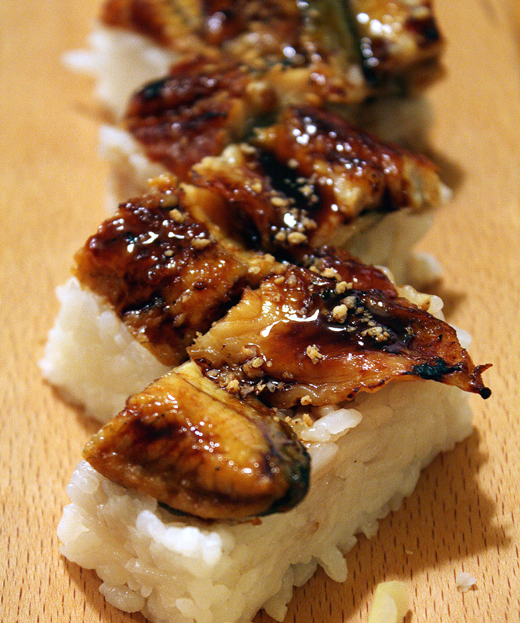
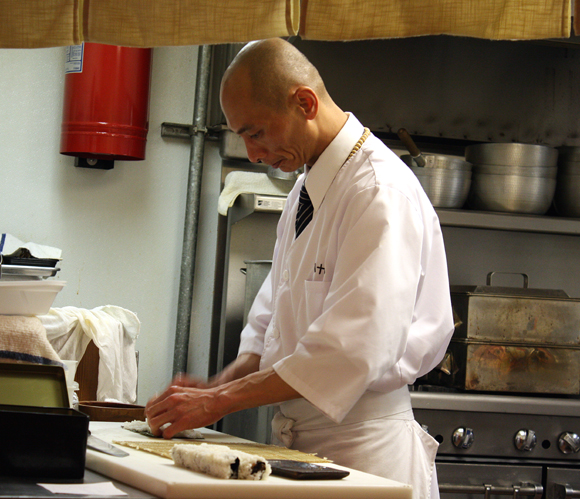
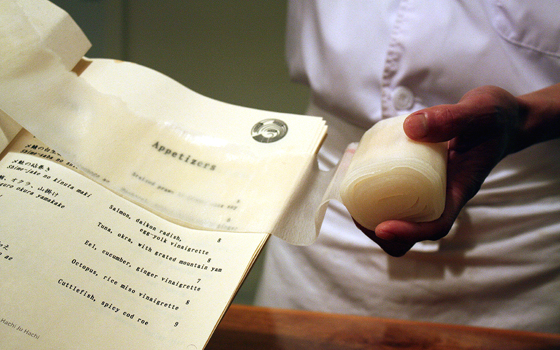
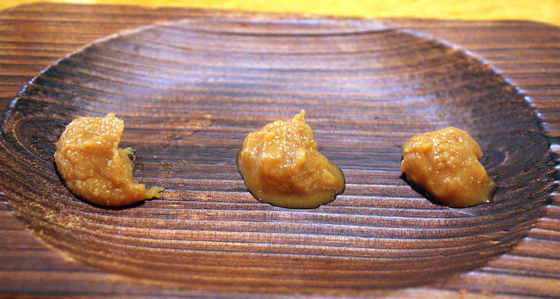

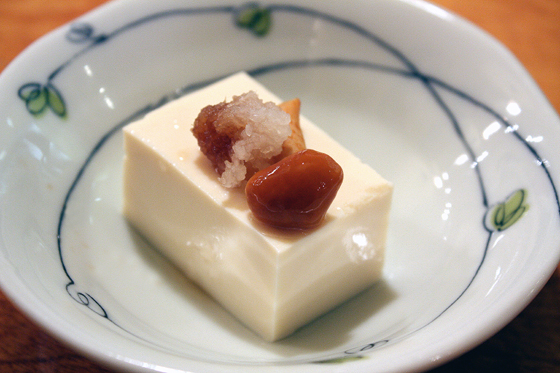
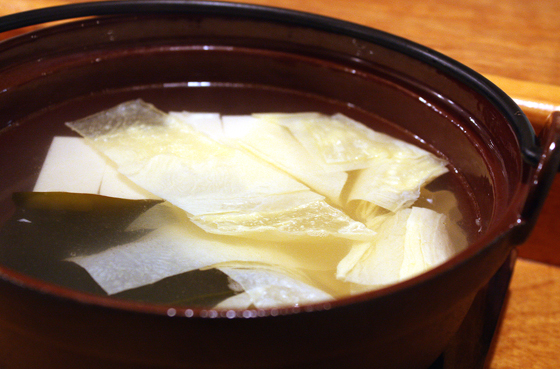
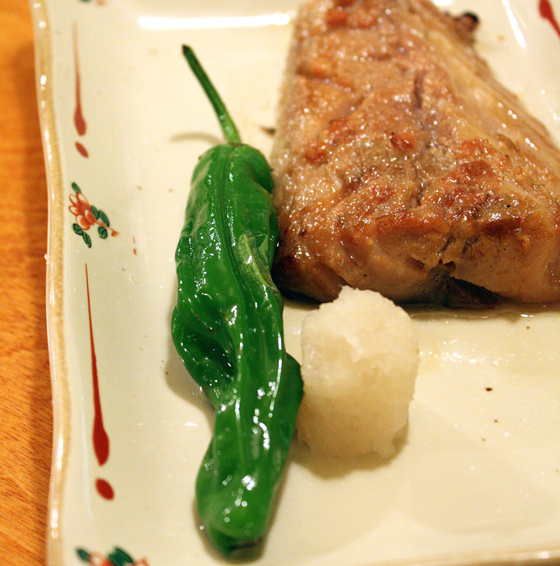

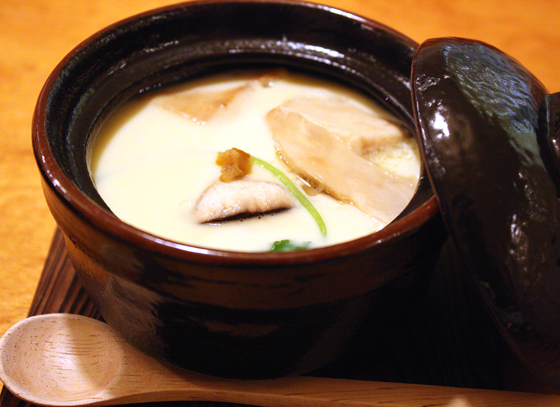

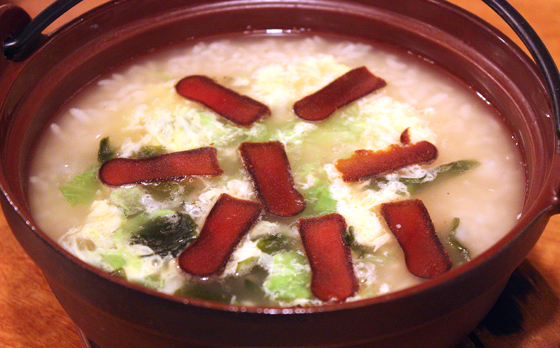
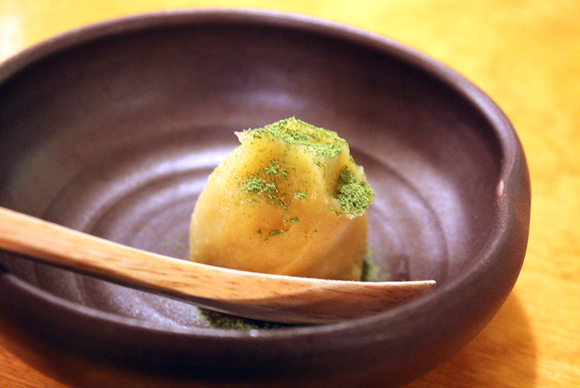
Sounds just amazing. That perfectly cut piece of tofu with the tiny mushroom looks incredibly delicious!
This restaurant is going on “my list.” Sounds wonderful.
Wonderful dishes here! I just saw a recipe for Chawan mushi on another foodie friend’s site and I’ve never had it before, I certainly need to try it!
Hachi Ju Hachi is definitely worth the trip to Saratoga. I hope average people learn to adapt their Japanese food wants because Jin has a lot to offer that is both tasty and unique. I’ve only been there during the week after 8, and unfortunately, the place has never been full.
I never experienced a washoku meal, and this looks lovely. Those floating bottarga looks so interesting.
What is the blistered pepper in the mackerel dish?
You aready had me hooked with the first photo of the unagi sushi, and then to tempt me further with that beautiful homemade tofu and custardy chawanmushi? Pure torture! I wish much success to Mr. Suzuki, hopefully locals are more willing to give traditional Japanese cuisine a try after reading your lovely review.
Tana: That is a shishito pepper. You can often find them in the produce section of Japanese markets. They’re great just fried up with a little oil and salt in a saute pan. They often have a little bit of heat to them, but nothing too scorching.
Wow. The food looks incredibly simple yet stunning. I love that you are usually able to give us an inside glimpse into the cooking /preparation process.
The chef…He has the intensity of a monk! Or maybe I’m thinking that bc he’s bald…heeehee.
Sophia: You are too funny! Actually, he does remind one of a Zen monk, especially when he talks about his philosophy about food. He also is quite humorous at times, too, so he’s not always that intense.
Carolyn: I figured it was the Japanese equivalent of a pimiento de padrón. Same preparation! Thanks!
Tana: Actually, it is kind of like a padron pepper, though the exterior of the shishito is a little different. The latter has a thin, almost papery skin over the pepper. Completely edible, just a different texture.
his cooking truly inspire, me too had a few kaiseki voyage, truly admirable and full of envy! wish i can figure out one or two creation, bummer I realized that I can’t!
Stop. Just stop. (No, don’t.) Duck in rice wine and soy broth. You’re killing me. I’m so looking forward to being in the Bay Area a week from tonight. I’m eating, eating, eating, and eating. Period. No questions asked.
Pingback: uberVU - social comments
Jin is an old friend and teacher – we have been in love with his dishes since 2000 when he was in Detroit. Those pictures have me checking for cheap flights to the Bay Area! Way to go OJ, we will see you soon.
A gorgeous post Carolyn and it really puts tofu in a different light! I know some people don’t like it but when it’s made and presented like this, that would completely change one’s mind!
Looks like a man who puts great pride in how and what he prepares and cooks.
88 is a very lucky and auspicious number to Chinese ;p
It is why I love living and learning from these amazing Japanese chefs. Thank you Carolyn for sharing these wondeerfully delicious photos! Oshii!! (deeelicious in Japanese)
http://jackieallen.jp
Hachi ju Hachi IS everything that you think it will be and more.
A heavenly dining experience. My kids (10 and 5 yrs) even love it, so families definitely give it a try. The kid friendly room is a plus. Jin has a great sense of humor, and is very warm.
That looks incredible! If only it were on the opposite coast…
That’s one serious lookin’ dude. That karasumi zosui looks incredible. Such a great idea!
Wow, what a great story accompanied with a lovely meal. His discipline can be really seen through his cooking and THAT knife skill, to be able to peel radishes paper thin with consistent thickness is no easy feat. Simple cooking with emphasizes on the ingredients is what made me fell in love with Japanese cooking. like you said, there are so much more to Japanese food than just sushi/tempura/teriyaki. Looking at this really brings us back to Kyoto. Thanks. I will add this as another reason why we should move to the Bay Area.
This looks simply amazing! I cannot wait to check it out – I must make a road trip to the South Bay, and soon!
This restaurant is the most authentic Japanese restaurant in the US.
I really recommend this restaurant to the people who are very sensitive to delicate flavor.
I am very lucky because I need to pay over $500 for Kaiseki in Japan.
Pingback: Food Gal » Blog Archiv » San Jose’s Bluefin Restaurant — Where Sharks Gather
How lucky you are to have OJ on your side of the country! I have very fond memories of OJ when he had his restaurant in Michigan. We had lots of laughs, and one of my favorite stories to tell of all time is about him. In case he’s reading this, I hope you know how many folks in the Detroit area miss you! xoxox
Pingback: Food Gal » Blog Archiv » At Bushido in Mountain View, There’s More than Meets the Eye